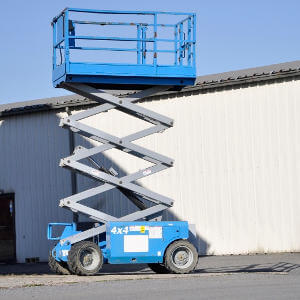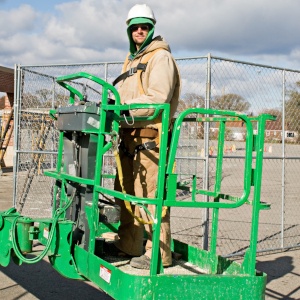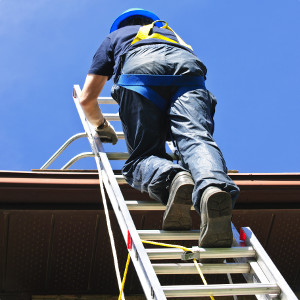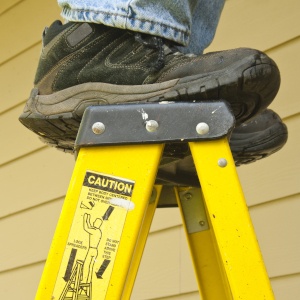How do you know when it’s better to use a mobile elevated work platform?
|
Most work from a ladder can be made safer by substituting the ladder with a mobile elevated work platform (MEWP). Sounds wrong, doesn’t it? After all, MEWPs are large pieces of machinery, with the potential for tip-overs, falls from the basket, and struck-by injuries. However, ladder use has risks as well. So, how do you know when it’s better to use a MEWP? When is it best to choose a ladder? And, which is the truly safer option?
|
 |
Determining risk is essential prior to making a final decision about how to safely get the job done
Mobile Elevated Work Platforms
|
There are several reasons to choose MEWPs over ladders. MEWPs have higher lift capacity than most ladders. This means that workers can work from greater heights safely, and without having to use very tall ladders. Their wider base also allows for greater stability during work, and for both hands to be free in order to complete more complicated tasks. With the use of appropriate fall arrest harnesses, the severity of injury resulting from a fall from a MEWP can be drastically reduced.
Using a MEWP prevents misuse of ladders, especially where they don’t quite reach, or where the load may exceed the maximum rating of the ladder. |
 |
Ladders
 |
Ladders are an obvious choice if a MEWP cannot be accommodated in the space. Ladders should only be used when the risk is considered to be low, and the duration of use short. When deciding whether a ladder is appropriate, risk should be the determining factor.
Ladders should only be used if the ground is level and stable, if the weight of the user AND their equipment does not exceed the maximum for the grade, and if the ladder was inspected prior to use and determined to be in good working order. |
Mobile elevated work platform and ladder safety education will teach workers to assess risks when deciding which tool is right for the job
Assessing the Risk
To assess risk, consider probability and severity:
Consider the following scenario: A worker is required to access the ceiling of a gymnasium to install speakers. They lean a tall ladder up against the wall but find when they get to the top with their tools and the speaker, that they can’t quite reach the work. So, the worker uses a steel beam for his right foot and keeps his left on the ladder, which gives them enough reach to use both hands to get the job done. In total, the job takes 45 minutes.
How probable is it that this worker could get injured? It’s very probable. They only had one foot on the ladder for the duration of the work, and they were on the ladder for longer than is recommended. As well, it’s uncertain whether the worker’s weight exceed the maximum when they carried the speaker and tools up the ladder. How severe could the worker’s injuries have been? A fall from height can result in serious injury and even fatality. Since this worker was working in a gymnasium, a MEWP could have easily been accommodated, and in this scenario, it would have been a much safer alternative to a ladder.
- Ask yourself, how probable is it that the hazard (in this case, ladder use) will result in an injury?
- Then ask yourself, how severe would a sustained potential injury be?
Consider the following scenario: A worker is required to access the ceiling of a gymnasium to install speakers. They lean a tall ladder up against the wall but find when they get to the top with their tools and the speaker, that they can’t quite reach the work. So, the worker uses a steel beam for his right foot and keeps his left on the ladder, which gives them enough reach to use both hands to get the job done. In total, the job takes 45 minutes.
How probable is it that this worker could get injured? It’s very probable. They only had one foot on the ladder for the duration of the work, and they were on the ladder for longer than is recommended. As well, it’s uncertain whether the worker’s weight exceed the maximum when they carried the speaker and tools up the ladder. How severe could the worker’s injuries have been? A fall from height can result in serious injury and even fatality. Since this worker was working in a gymnasium, a MEWP could have easily been accommodated, and in this scenario, it would have been a much safer alternative to a ladder.
 |
Now consider this scenario: An employee is asked to retrieve a box from a shelf that is about a foot above their head. The box is heavy, and the worker doesn’t want to reach on tiptoe. They use a well-maintained, lightweight steel two-step stepladder with a maximum weight of 350lb., on a cement warehouse floor. They step up one step, retrieve the box, and step down. The worker was on the ladder for under a minute.
How probable was an injury? Not very probable. How severe would an injury have been? Not very severe. In this case, the risk was low enough to make the use of the ladder a safe and reasonable option. |
Final Verdict
In most cases, a MEWP provides an excellent and safe alternative to ladder use. However, determining risk is essential prior to making a final decision about how to safely get the job done. A ladder is not always safer, and both pieces of equipment carry unique risks.
It is essential to participate in training prior to MEWP or ladder use. MEWPs must be controlled by competent operators, who must successfully complete training and a practical skills evaluation. For workers who frequently use ladders, ladder safety training is vital. MEWP and ladder safety education will teach workers to assess risks when deciding which tool is right for the job.
It is essential to participate in training prior to MEWP or ladder use. MEWPs must be controlled by competent operators, who must successfully complete training and a practical skills evaluation. For workers who frequently use ladders, ladder safety training is vital. MEWP and ladder safety education will teach workers to assess risks when deciding which tool is right for the job.
Trust MidSouthWest Training and Consulting
MidSouthWest Training and Consulting offers Mobile Elevated Work Platform training and Ladder Safety training. We also offer consulting and risk assessment services. You can trust MidSouthWest Training and Consulting to provide you with cost-effective training solutions tailored to meet your organization’s unique health and safety needs.
To ask questions about MEWPs, ladders, or risk assessment, contact us online or call 289.309.1143. Visit us 24/7 on the web at midsouthwest.ca.
To ask questions about MEWPs, ladders, or risk assessment, contact us online or call 289.309.1143. Visit us 24/7 on the web at midsouthwest.ca.
Last updated February 21, 2020




